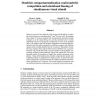Free Online Productivity Tools
i2Speak
i2Symbol
i2OCR
iTex2Img
iWeb2Print
iWeb2Shot
i2Type
iPdf2Split
iPdf2Merge
i2Bopomofo
i2Arabic
i2Style
i2Image
i2PDF
iLatex2Rtf
Sci2ools
NIPS
2000
2000
Dendritic Compartmentalization Could Underlie Competition and Attentional Biasing of Simultaneous Visual Stimuli
Neurons in area V4 have relatively large receptive fields (RFs), so multiple visual features are simultaneously "seen" by these cells. Recordings from single V4 neurons suggest that simultaneously presented stimuli compete to set the output firing rate, and that attention acts to isolate individual features by biasing the competition in favor of the attended object. We propose that both stimulus competition and attentional biasing arise from the spatial segregation of afferent synapses onto different regions of the excitable dendritic tree of V4 neurons. The pattern of feedforward, stimulus-driven inputs follows from a Hebbian rule: excitatory afferents with similar RFs tend to group together on the dendritic tree, avoiding randomly located inhibitory inputs with similar RFs. The same principle guides the formation of inputs that mediate attentional modulation. Using both biophysically detailed compartmental models and simplified models of computation in single neurons, we d...
| Added | 01 Nov 2010 |
| Updated | 01 Nov 2010 |
| Type | Conference |
| Year | 2000 |
| Where | NIPS |
| Authors | Kevin A. Archie, Bartlett W. Mel |
Comments (0)

